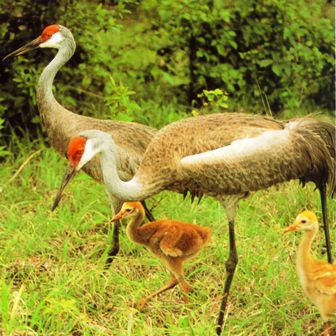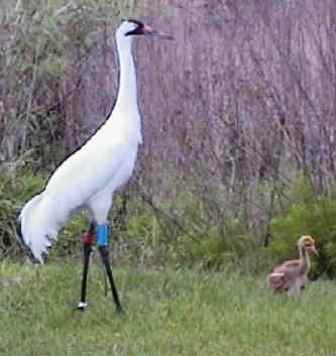Discover Florida Nature
It's time to explore the natural Florida


|
|
|
|
|
 Sandhill
Crane- Sandhill cranes (Grus canadensis) are long
legged, long necked, gray, heron-like birds with a patch of bald red
skin on top of their head. Sandhill cranes occur in pastures, prairies
and
freshwater wetlands in
peninsular Florida from the Everglades to the Okefenokee Swamp. Cranes
fly with necks outstretched like geese whereas, herons fly with necks
tucked in on their backs. For positive identification, look for reddish
skin on top of the crane's head. Cranes are quite omnivorous feeding on
seeds, grain, berries, insects, earthworms, mice, small birds, snakes,
lizards,
frogs, crayfish, but do not "fish" like herons.
Sandhill cranes nest during late winter and spring on mats of vegetation
about two feet in diameter and in shallow water. The Sandhill Crane does
not breed until it is two to seven years old. Two eggs are normally
laid. Cranes are monogamous breeders, and mated pairs stay together year
round, and migrate south as a group with their offspring. Within 24
hours of hatching, the young are capable of following their parents away
from the nest. Together, they forage for seeds and roots, crop plants
such as corn and peanuts, insects, snakes, frogs and occasionally young
birds or small mammals. Sandhill
Crane- Sandhill cranes (Grus canadensis) are long
legged, long necked, gray, heron-like birds with a patch of bald red
skin on top of their head. Sandhill cranes occur in pastures, prairies
and
freshwater wetlands in
peninsular Florida from the Everglades to the Okefenokee Swamp. Cranes
fly with necks outstretched like geese whereas, herons fly with necks
tucked in on their backs. For positive identification, look for reddish
skin on top of the crane's head. Cranes are quite omnivorous feeding on
seeds, grain, berries, insects, earthworms, mice, small birds, snakes,
lizards,
frogs, crayfish, but do not "fish" like herons.
Sandhill cranes nest during late winter and spring on mats of vegetation
about two feet in diameter and in shallow water. The Sandhill Crane does
not breed until it is two to seven years old. Two eggs are normally
laid. Cranes are monogamous breeders, and mated pairs stay together year
round, and migrate south as a group with their offspring. Within 24
hours of hatching, the young are capable of following their parents away
from the nest. Together, they forage for seeds and roots, crop plants
such as corn and peanuts, insects, snakes, frogs and occasionally young
birds or small mammals.Two subspecies of sandhill crane occur in Florida. The Florida sandhill crane (G. c. pratensis), numbering 4,000 to 5,000, is a non-migratory year-round breeding resident. They are joined every winter by 25,000 migratory greater sandhill cranes (G. c. tabida), the larger of the two subspecies. The two subspecies found in Florida are indistinguishable from each other; both have gray plumage and an unfeathered carmine red crown. The greater sandhill crane winters in Florida but nests in the Great Lakes region. Resident sandhill cranes are usually seen in very small groups or pairs. In November and December, however, large flocks of northern cranes move in, more than doubling the population in the state and then leave during March and April. The sandhill crane is a close relative to the nearly extinct whooping crane, which is being reintroduced into the state. Young sandhills weigh about twelve pounds, males are larger than females, but external markings are identical. Cranes live to be older than most birds, some reaching 20 years old.  Whooping
Crane- The tallest bird in North America, the Whooping Crane
was once at the brink of extinction. It is making a steady recovery
thanks to intensive management efforts in Canada and the United States,
and As of April 2007 there were about 340 whooping cranes living in the
wild, and another 145 living in captivity. The whooping crane is still
one of the rarest birds in North America. Whooping cranes occurred
naturally in the eastern United States until the mid-twentieth century,
and there are records of whooping cranes in Florida until the 1930s. The
whooping crane is endangered mainly as a result of habitat loss. At one
time, the range for these birds extended throughout Midwestern North
America. Whooping
Crane- The tallest bird in North America, the Whooping Crane
was once at the brink of extinction. It is making a steady recovery
thanks to intensive management efforts in Canada and the United States,
and As of April 2007 there were about 340 whooping cranes living in the
wild, and another 145 living in captivity. The whooping crane is still
one of the rarest birds in North America. Whooping cranes occurred
naturally in the eastern United States until the mid-twentieth century,
and there are records of whooping cranes in Florida until the 1930s. The
whooping crane is endangered mainly as a result of habitat loss. At one
time, the range for these birds extended throughout Midwestern North
America.
Adult whooping cranes are white with a red crown and a long, dark, pointed bill. Immature whooping cranes are pale brown. While in flight, their long necks are kept straight and their long dark legs trail behind. Adult whooping cranes' black wing tips are visible during flight. Whooping Cranes stand nearly 5 feet, and have a wingspan of 7.5 feet. A male whooping crane's average weight is 17 pounds, while the female weighs in at around 14 pounds. Whooping Cranes nest on the ground, usually on a raised area in a marsh. The female lays 1 or 2 eggs, usually in late-April to mid-May. The blotchy, olive-colored eggs average 2½ inches in breadth and 4 inches in length. Both parents brood the young, although the female is more likely to directly tend to the young. Usually no more than one young bird survives in a season. The parents often feed the young for 6–8 months after birth and the completion of the offspring-parent relationship occurs after about 1 year. Whooping Cranes are territorial in both summer and winter, living in family groups. Newly paired cranes often locate their first territory near that of their parents. The whooping crane's lifespan is estimated to be 22 to 24 years in the wild. These birds forage while walking in shallow water or in fields, sometimes probing with their bills. They are omnivorous and slightly more inclined to animal material than most other cranes. In their Texas wintering grounds, this species feeds on various crustaceans, mollusks, fish (such as eel), berries, small reptiles and aquatic plants. Potential foods of breeding birds in summer include frogs, small rodents, smaller birds, fish, aquatic insects, crayfish, clams, snails, aquatic tubers and, berries. Waste grain, including wheat and barley, is an important food for migratory birds such as the whooping crane. |
|
|
Advertise | Privacy Statement | Contact | Alaska Nature | Michael Arnold Art| Dog Encyclopedia | Dog Encyclopedia| |
|